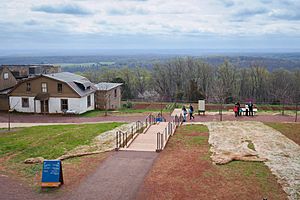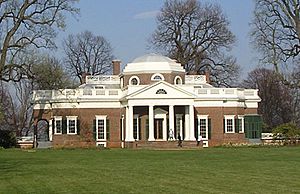John Hemings facts for kids
Quick facts for kids
John Hemmings
|
|
|---|---|
| Born | 1776 |
| Died | 1833 (aged 56–57) |
| Nationality | American |
| Occupation | Carpenter, cabinetmaker |
| Spouse(s) | Priscilla |
| Parent(s) | Betty Hemings Joseph Neilson |
| Relatives | Hemings family |
John Hemmings (1776 – 1833) was a very talented American woodworker. He was born into slavery at Thomas Jefferson's home, Monticello. John was part of the large mixed-race Hemings family. He learned his skills in the Monticello Joinery. He became a highly skilled carpenter and woodworker. John made beautiful furniture and fine wooden details for the insides of Monticello and Poplar Forest.
Hemmings also taught carpentry to younger apprentices. These included Beverley, Madison, and Eston Hemings. These young men were his nephews.
After many years of hard work, John Hemmings became a free man in 1826. This happened through Jefferson's will. He was also given all the tools from the joinery. He stayed at Monticello until about 1831 and passed away in 1833.
Contents
John Hemmings's Early Life & Learning
John Hemmings was born into slavery at Monticello on April 24, 1776. He was the youngest son of Betty Hemings. His father was Joseph Neilson, an Irish workman. Neilson was Jefferson's main carpenter at Monticello. John was Betty's eleventh child. He was also a half-brother to Sally Hemings.
A law from 1655 in the Virginia House of Burgesses said that a child's status (slave or free) came from their mother. So, John Hemmings was considered a slave. The Hemings family came to Monticello when John Wayles's daughter, Martha Wayles, married Thomas Jefferson.
Most of the Hemings family stayed close to each other for their whole lives. Thomas Jefferson's records of enslaved people at Monticello did not change much. About 70 family members from five generations lived at Monticello. Because they stayed in one place, family members saw each other every day.
Hemings children grew up knowing their future roles. Girls would work in the house. Boys would become butlers, valets, or skilled workers. These artisans worked in the many buildings on Mulberry Row. Jefferson gave the Hemings family more freedom than was common then. The men could travel alone and learn trades. They could also work for others on their free days and keep the money. The Hemings women did not do farm work. Instead, they did chores like childcare, sewing, and baking.
As a child, Hemmings worked in the fields. At age 14, he became an "out-carpenter." He worked in the woods, cutting trees. He also built fences, barns, and three slave cabins on Mulberry Row. At some point, Hemmings learned to read and write. It is not clear when or who taught him. He spelled his name with a double 'm', unlike the rest of his family.
John Hemmings's Marriage & Family Life
Even though slave marriages were not legally recognized in Virginia, John married Priscilla. They had a lifelong partnership. Priscilla worked as a nursemaid for Thomas Jefferson's grandchildren. She first worked at Edge Hill. Later, she lived with John at Monticello.
Jefferson's grandchildren liked Hemmings very much. They called him "Daddy." They often asked him to make them small wooden gifts. He even wrote letters to Jefferson's granddaughter, Septimia Randolph. Priscilla and John were very religious. They held church services in their cabin. They did not have their own children. However, they were close to Sally Hemings's three boys. When Priscilla died in 1830, Hemmings spent over a year carving her headstone himself.
John Hemmings's Amazing Career as a Woodworker
In the Monticello Joinery, Thomas Jefferson hired white joiners. They trained and worked alongside enslaved joiners. John Hemmings started his training at age 17 in 1793. Thomas Jefferson wrote to his son-in-law, Tom Randolph. He asked Randolph to make sure Hemmings learned from the house joiner, David Watson. Hemmings learned to make wheels and work with wood.
The Monticello Joinery had many tools and materials. Jefferson was always improving his properties. So, there were always projects to finish. Hemmings had the benefit of both materials and experience. Hemmings later worked as the main helper to James Dinsmore, another Monticello joiner.
At the Monticello Joinery, Hemmings helped improve Monticello. He also helped build Poplar Forest.
At Monticello, Jefferson asked Hemmings and Dinsmore to build small enclosures. These were on the south side of the building. They had louvered blinds. These blocked views into Jefferson's bedroom and study. Hemmings turned one enclosure into an aviary. This was probably for Jefferson's mockingbirds. Hemmings also built the Chinese railing, Venetian blinds, and cellar sashes. He made the bedchamber closet and window shutters at Monticello.
Jefferson started building his octagonal house, Poplar Forest, in 1806. It was finished around 1809. At Poplar Forest, Hemmings created the fancy trim inside. He also worked on the roof, including the decorative railing. He installed a large skylight in the center. He repaired it after a storm in 1819. He installed plaster decorations made by sculptor William Coffee. Hemmings also made repairs after a roof leak in 1819 and a fire in 1825. Hemmings took his nephews Beverley, Madison, and Eston Hemings to Poplar Forest. He taught them the basics of carpentry and joining.
In 1809, Hemmings took charge of the Monticello joinery. By this time, most of Monticello's outside was done. But the inside was not yet complete. Most of the furniture was very old. The joinery then started making furniture. They made pieces for both Monticello and Poplar Forest. The Monticello Joinery made desks, chairs, and tables. These were often based on Jefferson's own designs.
Hemmings likely made much of the furniture and woodwork after 1809. But only eight pieces are definitely known to be his. These include a "Campeachy" chair, boxes for books, a desk for Jefferson's granddaughter, a bedstead, a chess table, Pembroke tables, a hanging cabinet, and a dressing table. Some of these pieces were lost or destroyed over time. The hanging cabinet, made of walnut and poplar, still exists. It was meant for doll clothes for Jefferson's granddaughter, Septimia Anne Randolph.
The mahogany Campeachy chair Hemmings made for Jefferson was sold in 1970. Jefferson wanted a chair in this style, popular in New Orleans. He couldn't find one, so he described it to Hemmings. Hemmings made his own version. Later, he made at least two more chairs using an actual model. At least one chair made by Hemmings still exists today.
Hemmings thought the writing desk he made for Ellen Randolph Coolidge was his best work. Both he and Jefferson were sad when it was lost in a shipwreck. Another lost project was a four-person carriage. Hemmings made this in 1814 for an older Thomas Jefferson. Jefferson was tired of riding horses to Poplar Forest. Hemmings made all the parts for the carriage. His relative, Joseph Fossett, did the ironwork. Another relative, Burwell Colbert, painted the finished carriage. Jefferson was very proud of this carriage.
John Hemmings had special ways of working. These help identify his creations. He would attach shelves to the sides of a cupboard. He used a double-bead molding on the front of shelves. He also curved the molding on bed frames.
After Hemmings became the master craftsman, he trained other enslaved people. This included Thomas Jefferson's three nephews. At age 14, Beverley, Madison, and Eston became apprentices to Hemmings. They learned to be very skilled carpenters.
Thomas Jefferson and John Hemmings had a strong working relationship. They wrote letters to each other. They shared drawings about woodworking and house projects. Twelve of these letters still exist. Hemmings also told Jefferson when a slave named Nace stole food from the garden. Jefferson gave Hemmings a yearly bonus. This started in 1811 and was fifteen to twenty dollars. This was about one month's wages. When Jefferson became sick, Hemmings cared for him for two months. He also helped him walk.
On April 16, 1826, Thomas Jefferson wrote his will. He stated that John Hemmings would be freed one year after his death. Hemmings would also receive all his tools. He would get a house and an acre of land for his life. This was if he stayed near his wife Priscilla and the new University of Virginia. Hemmings was one of five Hemings family members freed in Jefferson's will. Hemmings was also given the service of his two nephews and apprentices, Madison and Eston Hemings. This was until they turned twenty-one. Madison was already 21 when Jefferson wrote his will, so he became free right after Jefferson died.
Thomas Jefferson died on July 4, 1826. He was buried in a coffin that John Hemmings made. Hemmings spent days, maybe weeks, making it from wood he saved. Jefferson's death made John Hemmings a free man at 51 years old.
Hemmings continued to live and work for pay at Monticello after Jefferson's death. He stayed until about 1831, when the house was sold. Jefferson's daughter, Martha Randolph, lived there until then. The loss of his family and his craft made him sad. He was supposed to live near the University of Virginia, but it seems he never worked there. Not much is known about Hemmings after 1831. The last record of him is from September 16, 1831. He registered with the county court, as all freedmen had to do. This record gives the only description of John Hemmings. It says he was just over five feet five inches tall. He had a light skin tone and a small scar on his right wrist. John Hemmings died in 1833.
John Hemmings's Legacy & Impact
Monticello has started rebuilding some of the slave cabins on Mulberry Row. These were taken down in the 1800s. One of the cabins is a rebuilt version of the home John Hemmings and his wife Priscilla shared. The furniture inside the cabin comes from a description in one of Jefferson's grandchildren's diaries. Monticello also offers a tour that explores the Hemings family's life there. The Joinery building is no longer standing, but its foundation and chimney are still there.
In 2012, an exhibition called Slavery at Jefferson’s Monticello: Paradox of Liberty opened. It was presented by the National Museum of African American History and Culture and the Thomas Jefferson Foundation. This exhibition showed Jefferson's complex role. He wrote the Declaration of Independence, but he also owned enslaved people. Some items on display included the "Campeachy" chair Hemmings made. There was also a copy of French chairs from Monticello, and a hanging cabinet made by Hemmings.
The entrance to Slavery at Jefferson’s Monticello: Paradox of Liberty had a large statue of Jefferson. He stood in front of stacks of bricks. Each brick had the name of one of the 607 enslaved people Jefferson owned. This included John Hemmings's name. This statue can still be seen today in the Paradox of Liberty section of the National Museum of African American History and Culture.
See also
- Sally Hemings
- Jefferson DNA data
- Monticello
- Poplar Forest



